

WARNING: This article contains deeply unfashionable topics - such as have been conscientiously and thoroughly devalued, demonised, ridiculed and distorted over the course of many centuries. In more modern times the pragmatic clinical synical scalpel of science has surgically removed such ideas from our shiny material world and banished them to the realms of fantasy and children’s stories… What am I saying, even children don’t read such things anymore.
● Fairy vs Faërie ○ Tolkien’s definition of the Realm of Faërie ○ Communion with other living things ○ Language of the Birds, of the Gods
● Iceland ○ Iceland's Elves and Hidden People ○ Fairy Preserves, Ringforts, Mounds, etc. ○ Tolkien’s Icelandic Nanny ○ The Inklings
● The Farfarers ○ The Peti, Papae & Finns ○ The Finnar/Saami/Lapps ○ Orkney ○ The Albans as Fae
● Disappearances ○ The Destruction of the Indies ○ Comparing New World Colonisation with Old ○ The Fae in the New World ○ Caucasian Native Americans ○ Physical Alchemy
● Other Vanishing Acts ○ Killer Diseases ○ Missing Persons
● The Realm of Faërie ○ Folklore ○ The Disappearance of the Fae ○ The Origin of The Fae

J.R.R. Tolkien Source
As J. R. R. Tolkien, said in his essay ‘On Fairy Stories’ back in 1939:
“It seems to become fashionable soon after the great voyages had begun to make the world seem too narrow to hold both men and elves; when the magic land of Hy Breasail in the West had become the mere Brazils, the land of red-dye-wood.”
Hy Breasail, or Hy Brazil, for those who have never heard of it before, is a mythical island akin to Atlantis (or maybe even Atlantis itself) that was frequently seen off the west coast of Ireland out in the Atlantic. Obviously, Tolkien was right because since 1939 the name seems to have disappeared from the general consciousness, unlike ‘Atlantis’.
Map of Abraham Ortelius 1570, cropped, showing Brasil island west of Ireland.
Public domain, click to enlarge
Anyway, I think his point was that the wonder and mystery people expected and hoped would be discovered in the world simply wasn’t there. Instead, there was just more of the same misery they had at home, but in places with different exotic names.
From that time on the Fae became literary figures who existed in pure fantasy only to entertain and beguile, such as those employed by Shakespeare and Michael Drayton. That was, of course, after they had been utterly demonised by Christianity.
Tolkien’s Essay is a treasure-trove which we will be plundering frequently throughout this quest.
“Fairy, as a noun more or less equivalent to elf, is a relatively modern word, hardly used until the Tudor period. The first quotation in the Oxford Dictionary (the only one before A.D. 1450) is significant. It is taken from the poet Gower: ‘as he were a faierie.’ But this, Gower did not say. He wrote as he were of faierie, ‘as if he were come from Faërie.’ Gower was describing a young gallant who seeks to bewitch the hearts of the maidens in church.” (Tolkien)
So maybe the word ‘fairy’ was a mistake then or simple laziness, a common error whereby ‘y’ is used instead of ‘ie’ and the ‘e’ in the middle was also dropped, although other better explanations will present themselves. This abbreviation was further confounded by erroneously using the word ‘faierie’ as the description of an entity rather than the name of the realm the entity came from. In his essay, Tolkien labours this point and always uses the word ‘Faërie’ to describe the realm that the Fae inhabit and never to describe an inhabitant. I believe the pronunciation is “fay-ree” and was used deliberately in order to distance his definition as far as possible from the modern concept of “fairies.”
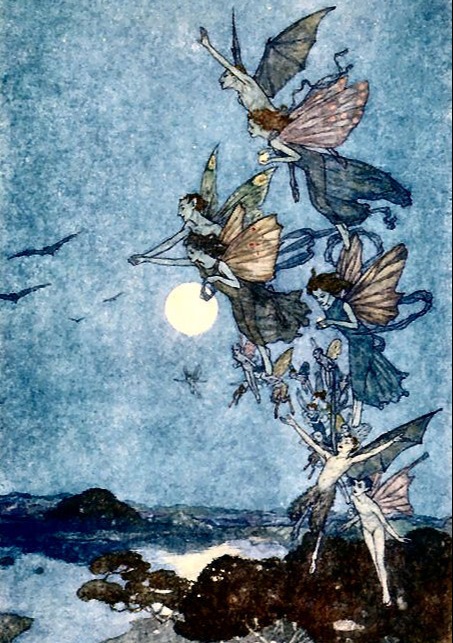
Shakespeare's Comedy of 'The Tempest' (Act V, scene I)
illustrated by Edmund Dulac
Source
Tolkien insisted that fairy-stories were not stories about fairies, but rather they were about the Realm of Faërie itself:
“Faërie contains many things besides elves and fays, and besides dwarfs, witches, trolls, giants, or dragons: it holds the seas, the sun, the moon, the sky; and the earth, and all things that are in it: tree and bird, water and stone, wine and bread, and ourselves, mortal men, when we are enchanted.” (Tolkien)
According to Tolkien, the Realm of Faërie is independent of considerations regarding fairies and elves - their nature, veracity or history – and fairy-stories are defined by and depend upon the nature of the Faërie Realm, “the Perilous Realm itself, and the air that blows in that country...
“Faërie cannot be caught in a net of words; for it is one of its qualities to be indescribable, though not imperceptible.”
Therefore, Tolkien’s stories are not defined by or dependent upon Hobbits, Elves or Ogres, but upon the nature of Middle-Earth of which such characters are an integral part. The same applies to Narnia, which isn’t defined or dependent upon a Wardrobe, the Snow Queen or Edmund’s love of Turkish Delight, but upon the nature of the place itself.

Samuelmat, CC BY-SA 3.0
Public domain
“The magic of Faërie is not an end in itself, its virtue is in its operations: among these are the satisfaction of certain primordial human desires. One of these desires is to survey the depths of space and time. Another is [as will be seen] to hold communion with other living things.” (Tolkein)
In relation to the intention behind this article, that last statement is highly significant. Of all the achievements attributed to mankind over the last several hundred years it’s perfection of isolation and alienation from all other living things has to be the greatest. Once, relationships with animals represented a huge part of our natural life. There was even a time when the hunter and the hunted held each other in mutual respect, as attested by the apparently contradictory definition of such supposedly mythological characters as Hern the Hunter.

Hern the Hunter
Source
We also had a much deeper relationship with nature and with the land, until people were herded into cities like cattle in a market. The food we eat comes from who knows where, not from home. Our homes don’t sustain us, they provide only shelter and partial distraction from the city. How can there be fairies at the bottom of your garden when you don’t have a garden?
“Tolkien once remarked to me that the feeling about home must have been quite different in the days when a family had fed on the produce of the same few miles of country for six generations, and that perhaps this was why they saw nymphs in the fountains and dryads in the wood—they were not mistaken for there was in a sense a real (not metaphorical) connection between them and the countryside. What had been earth and air and later corn, and later still bread, really was in them.” C.S. Lewis in a letter to Arthur Greeves, June 22nd, 1930
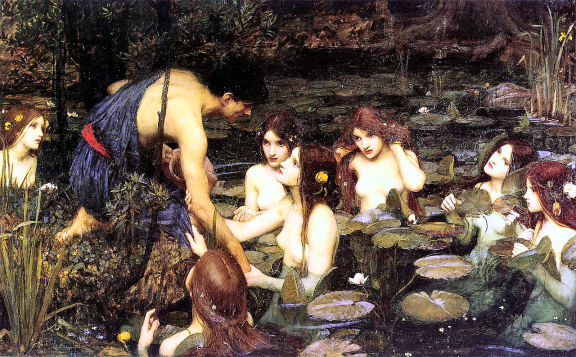
Hylas and the Nymphs, 1896, John William Waterhouse
Public domain
It’s very interesting to hear Tolkein’s own take upon the nature of ‘modern life’ and the future as he saw it some 80 years ago:
“The rawness and ugliness of modern European life — that real life whose contact we should welcome — is the sign of a biological inferiority, of an insufficient or false reaction to environment. The maddest castle that ever came out of a giant's bag in a wild Gaelic story is not only much less ugly than a robot-factory, it is also (to use a very modern phrase) “in a very real sense” a great deal more real. Why should we not escape from or condemn the “grim Assyrian” absurdity of top-hats, or the Morlockian horror of factories? They are condemned even by the writers of that most escapist form of all literature, stories of Science fiction. These prophets often foretell (and many seem to yearn for) a world like one big glass-roofed railway- station. But from them it is as a rule very hard to gather what men in such a world-town will do. They may abandon the “full Victorian panoply” for loose garments (with zip-fasteners), but will use this freedom mainly, it would appear, in order to play with mechanical toys in the soon-cloying game of moving at high speed. To judge by some of these tales they will still be as lustful, vengeful, and greedy as ever; and the ideals of their idealists hardly reach farther than the splendid notion of building more towns of the same sort on other planets.” ‘On Fairy Stories’, J.R.R. Tolkien, 1939
The introduction of mechanisation and inhuman methods of breeding and raising animals, caused more and more people to lose contact with them. When the automobile finally replaced the horse the last vestige of a relationship with anmals was lost. Now some people have pets, such as cats and dogs. Not all, but many of those people still hold on to that ancient “communication with other living things” through their pets. Clearly Tolkein was hinting at communication with the Fae, but the process of decay described in relation to animals has been exactly the same for any relationship we may have once had with the Realm of Faërie.
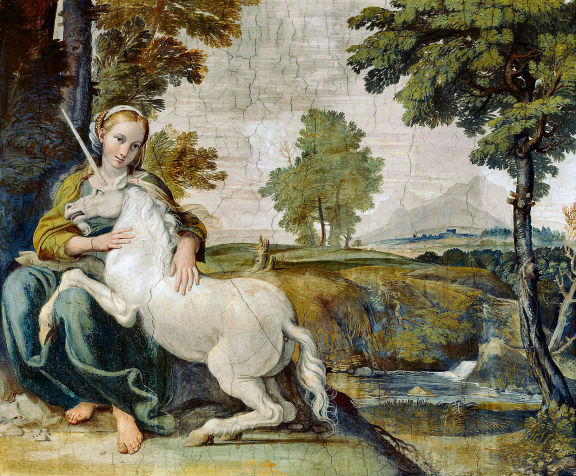
Virgin and Unicorn, c. 1602, Domenichino
Public domain
“The magical understanding by men of the proper languages of birds and beasts and trees, that is much nearer to the true purposes of Faerie.” (Tolkien)
The so-called Celtic Tradition has always held that animals are a bridge between our world and the hidden realms. Those “proper languages” Tolkein refers to have been long lost to us – probably and not uncoincidentally, for as long as we have lost any relationship we may have had with both animals and the Realm of Faërie.
I can’t help but mention one of our favourite quotes from ‘The Last Alchemist’, Fulcanelli, at this point:
“Though never spoken, the phonetic cabala, this forceful idiom, is easily understood and it is the instinct or voice of nature.”
“By contrast, the Jewish Kabbala is full of transpositions, inversions, substitutions and calculations, as arbitrary as they are abstruse. This is why it is important to distinguish between the two words, CABALA and KABBALA in order to use them knowledgeably. Cabala derives from cadallhz or from the Latin caballus, a horse; kabbala is from the Hebrew Kabbalah, which means tradition.
“...figurative meanings like coterie, underhand dealing or intrigue, developed in modern usage by analogy, should be ignored so as to reserve for the noun cabala the only significance which can be assured for it.” Fulcanelli, The Mystery of the Cathedrals.
The ‘Cabala’ was also known as the “language of the birds, of the gods.” (ibid, Fulcanelli) The reason that the word ‘Cabala’ derives from caballus, a horse, most likely stems from the fact that for centuries, the vast majority of people had a horse prior to the 1900s and would most likely have developed some kind of understanding with the animal.
“There are profounder wishes: such as the desire to converse with other living things. On this desire, as ancient as the Fall, is largely founded the talking of beasts and creatures in fairy-tales, and especially the magical understanding of their proper speech. This is the root, and not the “confusion” attributed to the minds of men of the unrecorded past, an alleged “absence of the sense of separation of ourselves from beasts.” A vivid sense of that separation is very ancient; but also a sense that it was a severance: a strange fate and a guilt lies on us. Other creatures are like other realms with which Man has broken off relations, and sees now only from the outside at a distance, being at war with them, or on the terms of an uneasy armistice. There are a few men who are privileged to travel abroad a little; others must be content with traveller's tales” (Tolkien).
So then, in a sense this article is about all that we have lost as a species. About how we have allowed ourselves to be excommunicated from the unimaginable wonder of belonging to an extended family that is as much a part of creation as we are. It’s about how we have denied our kinship with the vast majority of existence in the cause of organised belief and science.
But the loss doesn’t end there. What might our part in this extended family have been? Just who could we have become had we not exiled ourselves in our own vanity as ‘masters of all creation’?
I realise this has been a very long introduction, but those of you who have managed to make it this far are well prepared for what follows.
The Quest begins in Iceland
Once upon a time... only kidding. As if to completely contradict what we have just stated, we begin with a discussion of Iceland. It’s a fascinating place and its people are even more fascinating than the land itself. Approximately 50% of the population in Iceland believe in the existence of the Álfar and the Huldufólk, which translate as the Elves and the Hidden People. The state religion is Lutheran, although Ásatrú - a religion based upon the old Norse mythology - has a registered membership of about 5000 and is claimed to be on the increase.
Iceland’s history is typically vague. In general it’s claimed that when the Scandinavians arrived in the 10th century it was uninhabited, but then there are hints indicating that it wasn’t. These include Irish monks and some people called the Pappars about whom absolutely nothing is known.
The Scandinavians were fleeing from the persecution that was unleashed in Norway by the onslaught of Christianity. In fact the sagas even mention there being Christians amongst those who escaped to Iceland. Olaf Tryggvason, who was king of Norway at that time, imposed conversion to Christianity under the threat of violence. It’s claimed that the Scandinavians brought their slaves with them to Iceland, but others will tell you that they were not slaves, just employees. It’s worthwhile considering that giving something a historical precedent is an attempt to make it acceptable in more recent times.
There is more to be said about Norway, but that will come later. For now let’s focus on Iceland:

Icelandic Elf Houses
Source
With no native population, and no large predators, it seemed that the untamed elements were the only thing settlers would have to war against. But as time when on it became clear that amongst the black rocks and deep caves of this island lay ancient magic, and mystical people who had lived there since the giant ogre named Ymir appeared out of the thawing drops of a new, and fierce, world.
There are many reports of construction work being forced to reconsider its planning due to intervention in the form of inexplicable machinery failures when such features are threatened.
“Accordingly, construction projects including roads, factories, dams and hospitals are occasionally modified to protect elves or at least delayed to give them time to move to a new place. For some big projects, consultants with clairvoyant skills are brought in to ensure that there is no adverse impact on elves.” Source
“Fairy Preserves. A heap of stones in a field should not be disturbed, though needed for building - especially if they are part of an ancient tumulus. The fairies are said to live inside the pile, and to move the stones would be most unfortunate. If a house happens to be built on a fairy preserve, or in a fairy track, the occupants will have no luck. Everything will go wrong. Their animals will die, their children fall sick, and no end of trouble will come on them. When the house happens to have been built in a fairy track, the doors on the front and back, or the windows if they are in the line of the track, cannot be kept closed at night, for the fairies must march through.
“Near Ballinrobe [County Mayo in Ireland] there is an old fort which is still the preserve of the fairies, and the land round it. The soil is very fine, and yet no one would dare to till it. Some time ago in laying out a new road the engineers determined to run it through the fort, but the people rose almost in rebellion, and the course had to be changed. The farmers wouldn’t cut down a tree or bush growing on the hill or preserve for anything." Source: ‘Men Who Eat Ringforts’ by Sinéad Mercier, Michael Holly and Eddie Lenihan, 2020.
There were once around 60,000 fairy ringforts in Ireland. Now there are fewer than half remaining.
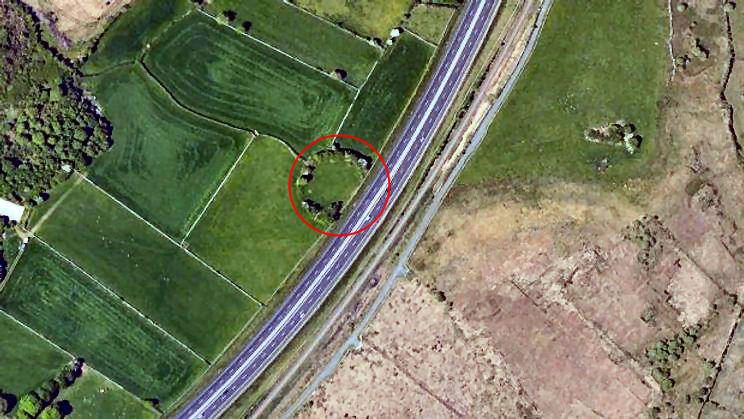
The M18 motorway between Crusheen and Gort in Ireland showing the destruction
of a Fairy Ringfort. Scene of an unusually high number of accidents.
Source
It is rumoured that the demise of the DeLorean Motor Company was due to the factory having been built upon a fairy preserve in Belfast ...as well as all the corruption.
Given that most Christian Churches, etc., are built upon sites that were already sacred, it’s not surprising to find that there are a great many similar stories connected with their construction. By the way, a fairy track, fairy path, ’ or fairy-pass were conceived “as actual magnetic arteries, so to speak, through which circulates the earth’s magnetism.” (ibid.) This was way before anyone had ever heard of Ley-Lines.
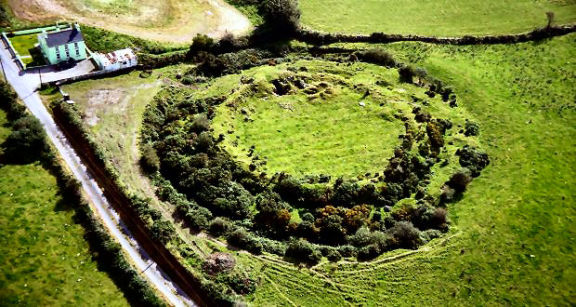
Cappeen Ringfort, Co Cork, Ireland
Source
Of course, these days the world’s media treats all of this with distain and usually attempts to explain it all as a marketing ploy for the tourism industry. No doubt there are those who would exploit such situations for financial gain, which is a much more readily accepted motive these days than the possibility of something genuine. Beside this there is also the familiar concept of the personification of natural forces, which will be discussed again in greater detail later.
The Icelandic word ‘Álfar’ covers a much wider variety of beings than just Elves. There are many different species of Fae reported to have been inhabiting Iceland from time immemorial. The Huldufólk though are much more specific. They are very humanlike, often taller and more handsome and possessed of great magical power. They shun human contact as a rule and prefer flight to fight, although there are stories of interaction and cooperation with humans. They claim that we are their “hidden people.”
“Tolkien never visited Iceland but a lot of his work was inspired by Iceland, Icelandic stories and the Icelandic language. The trolls in the Hobbit are from Icelandic folktales, Gandalf is the incarnation of Odin, a god from Norse mythology and so on and so on! So where did he get introduced to Iceland then?
“During his education he read and translated from old Norse (the parent language of Norwegian, Swedish, Danish and Icelandic). It became his secondary subject. Later in the early 1930´s, his children had a nanny. A woman from Iceland. She loved telling the children, and sometimes Tolkien, some interesting Icelandic Folklore before bedtime and also taught them all some Icelandic. He was fascinated by what he heard and decided to get to know all this even better. He learned Icelandic and immersed himself into all kinds of old books and manuscripts about the Icelandic sagas and did a lot of research on them.
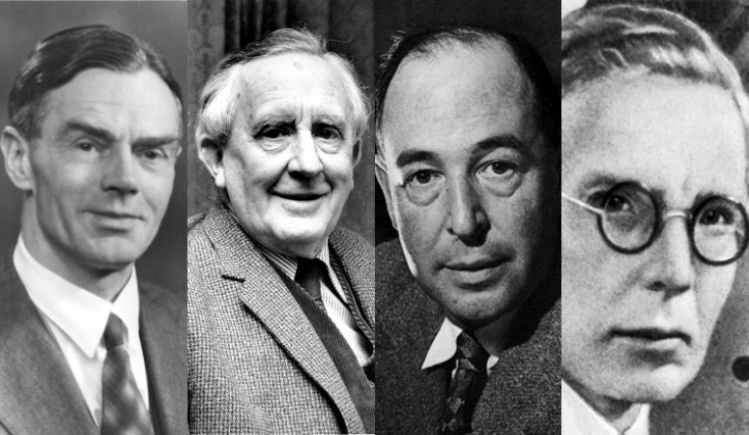
The Inklings - Owen Barfield, JRR Tolkien, CS Lewis and Charles Williams
Source
“Tolkien even founded a club that focused on the Icelandic sagas along with his friend C.S. Lewis, the author of The Chronicles of Narnia. They encouraged the reading, translations and discussion of Icelandic sagas in the original language. This club was originally called Kolbítur (Icelandic for the person who stays so close to the hearth or fire in winter that they bite on the coals) but when Tolkien, C.S. Lewis and more started writing their own Sagas they changed the name of the bookclub to The Inklings.” Source

For the next avenue of investigation I am very grateful to Maxresde of stolenhistory.net:
“I made a thread about a book called ‘The Farfarers’ by Farley Mowat, but I can't find it now. He argued in that book that the population of Britain prior to the Celts, Saxons, French Normans, etc there was another race of people who were very averse to fighting. They would fight if they were directly attacked, but they weren't war-like, wouldn't mount counter-attacks, etc. He said they preferred to just get out of the way. He called them the Albans for a lack of a better name.
“So he suggested that they retreated to Scotland as England was being colonized by different people, and by the time of the Vikings, they were withdrawing to Iceland. Then as the Vikings followed them to Iceland, they moved to Greenland. When the Vikings came to Greenland, they moved to the mainland of North America. He thought that they ultimately wound up in Newfoundland and kind of blended back in with the European population when they showed up.
“So I think in that other thread I made some other time, I was saying that there was a report from these Italian guys Zeno in the 1300s that were working for someone named Zichmni, who may or may not have been Henry Sinclair. But in the Zeno story, they came to an island where the people there fought as if their lives depended on it, to keep the explorers off of their island. I was saying that the Beothuk people in Newfoundland had a reputation for absolutely refusing to make contact with any outsiders until finally they disappeared. It kind of sounded a bit like what Mowat's people might have been like by the time they got chased all the way to Newfoundland.
“So, what I wanted to add to that, was that I was thinking today about the Arctic population prior to the Eskimos, who are known as the Dorset culture. When the Eskimos came in, they described the pre-existing population as being very shy and non-violent. The Dorsets supposedly would just move away whenever they were confronted by the newcomers.” Source
Thirty-five years prior to the 1998 publication of ‘The Farfarers: Before The Norse’, Farley Mowat had let lose his controversial theory that the Norse were the first Europeans to discover North America (Westviking, 1965.) His later work, outlined above, went down like a ton of bricks with academia, which is a shame in our opinion as I think he was on to something, although maybe not exactly what he envisioned.
Apart from the ever westward migrations of the Albans, who were apparently in search of walrus ivory [and probably named after ‘Albion’ - the Greek name for the British Isles,] another part of the conundrum he hoped to resolve was that concerning mysterious “large cylindrical rock ‘beacons’ visible from the sea, which were obviously intended for boats to find the sites. The sites were obviously re-used in annual cycles of activity.” Source
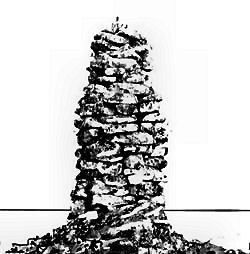
Typical cylindrical pillar of rocks often over 6 ft (2 m) tall
Source
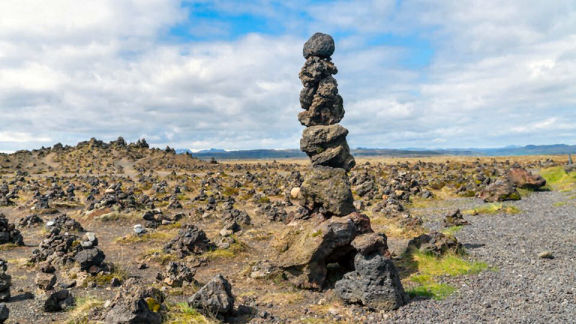
Do these ‘beacons’ look familiar?
In Iceland they are the dwellings of the Álfar and the Huldufólk
“Mowat's map of the cylindrical beacons in the Canadian arctic shows them widely distributed on the Canadian east and arctic coast. The wide distribution of these ‘beacons’ -- in Ungava Bay, Hudson Strait, eastern Hudson Bay, down the Labrador coast, etc. Mowat continued: (p 162) ‘Tower beacons of this type are also found on Britain's Northern and Western Isles, Iceland, western Greenland, the eastern Canadian high arctic, the Atlantic coast of Labrador, and Newfoundland.’ I add that other sources say they can be found on the Norwegian coast too.” Source

Mowat’s Map of ‘beacons’ Source
The Vinland Sagas contain two independent accounts of Norse voyages to Greenland and Vinland – generally taken to refer to North America:
“It is interesting to note that aboriginals in skin boats appear in the Vinland Sagas: ‘But one early morning as they looked around they caught sight of nine skin-boats: the men in them were waving sticks which made a noise like flails, and the motion was sunwise. ...They were small and evil-looking, and their hair was coarse; they had large eyes and broad cheekbones’ (Eirik's Saga, 10)” (ibid.)
These ‘aboriginals’ don’t exactly meet the human criteria. Could they be Fae?
“Originally it was the "Peti" and the "Papae" who inhabited these [Northern British] islands. The first of these people, I mean the Peti, were scarcely taller than pygmies. Morning and evening they busied themselves to an amazing degree with the building and fitting out of their towns. But at midday, thoroughly drained of all their strength, they lay low in their little underground houses under the pressure of their fears…” Source (ibid)
These were definitely Fae. The name Papae sounds somewhat similar to the Pappars who were rumoured to be the pre-Scandinavian inhabitants of Iceland. Of course, both the Peti and the Papae simply disappeared, much like the Pappars, although Farley Mowat surmises:
“Existing Shetland traditions speak of a people called Finns who inhabited Fetlar and northwest Unst for some time after the Norse occupied Shetland. This name is identical with the one by which the Norse knew the aboriginals of northern Scandinavia. It is also the name given by Shetlanders (of Norse lineage) to a scattering of Inuit, who, in kayaks, materialized amongst the Northern Isles during the eighteenth century.” Farley Mowat, Farfarers, p 110.
It’s interesting to note that in Old Irish the word Finn means "white, bright, lustrous; fair, light-hued (of complexion, hair, etc.); fair, handsome, bright, blessed; in moral sense, fair, just, true." Fair as in Fairy. Finn is also the name of one of Ireland’s greatest heros, Finn mac Cumai. The same character is also common to Scottish and Manx folklore.
Now we have to nip back across to Norway for some more detailled information to guide our quest...
“Norway was, and still is, home to two distinctly different people - the Norwegians, and the indigenous inhabitants of Northern Scandinavia, the Saami [also known as Lapps].
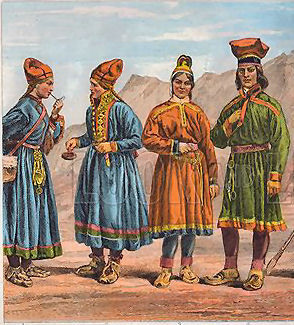
Swedish Lapps left, Norwegian Lapps right, circa 1899
Source
“Referred to in the Old Norse sources as ‘Finnar’, the Saami were regarded as great sorcerers with the power to control the weather, travel great distances in magical trances and shapeshift - usually into the form of a sea animal or bear. [Please BEAR that in mind for later.]
“The Saami led a nomadic life, with a completely different culture and society to that of their Norwegian neighbours.
“They lived primarily in the far north of Norway in a territory known as ‘Finnmark’. The Finnmark of ancient times was much greater than the current area, with records showing that the Saami were also found in areas of southern and eastern Norway.
“Although the two peoples may have influenced various aspects of each other’s religion and culture, there remained distinct differences.
“After the Norwegians adopted Christianity [under threat of violence], for example, the Saami remained pagan - a fact that no doubt enhanced their reputations as heathen sorcerers.
“Living apart from the Norwegian people, the ‘otherworldliness’ of the Saami can also be seen from Old Norse literature.
“Here they are sometimes referred to as jotnar (giants) and dvergar (dwarfs) - descriptive terms unlikely to refer to their size or stature, but instead firmly placing them in a realm of myth, magic and the supernatural.
“The Saami had a shamanistic religion, something that undoubtedly served as the basis for the later Norse traditions that the ‘Finnar’ were renowned magic workers. Their powers of healing and prophecy, control over the weather and the ability to shapeshift are all magical abilities that are also found clearly attributed to the Finfolk and selkie-folk in Orkney and Shetland folklore.
“In Norway, the Saami’s reputation was such that there were laws forbidding Christians from having any contact with the ‘Finnar’ or going to them seeking knowledge of the future or healing.
“One of the oldest accounts relating to the Saami culture was written in Sweden after the 30 Years War. During this conflict, we learn, that the Swedes were accused of using Saami witchcraft.
“I believe that the traditions surrounding the ‘Norway Finns’ - as they later became known in Orcadian tradition - travelled with the Norsemen into Orkney and Shetland. There it took root and gave birth to the folklore of the Finfolk.” Source
“In Norway, a major effort to convert the Sámi was made around 1720, when Thomas von Westen, the “Apostle of the Sámi", burned drums, burned sacred objects, and converted people. Out of the estimated thousands of drums before this period, only about 70 are known to remain today, scattered in museums around Europe. Sacred sites were destroyed, such as sieidi (stones in natural or human-built formations), álda and sáivu (sacred hills), springs, caves and other natural formations where offerings were made.” Source
“After their Christian conversion, the lifestyles of Sami children began to change. Missionary schools kept children from their parents for much of the year. Teachers encouraged children to speak in majority languages at the expense of their own.” Source
Not enough remains concerning the traditions of the Finnar / Saami / Lapps, but hopefully by examining similar cultures it will become obvious that not every single individual possessed supernatural abilities and that there was a specific group within their culture, possibly Fae, who did. The situation of a Fae, demigod-like race living amongst humans - who are then persecuted and forcibly converted to Christianity - will come up again. And again and again...
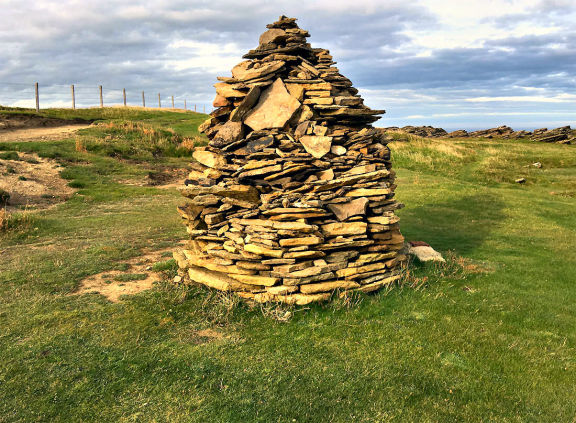
Isbister, South Ronaldsay, Orkney, Scotland
Source
Recently Orkney has been re-evaluated by mainstream archaeology. It is now claimed that Orkney was the origin and centre of ancient British culture, even pre-dating Stonehenge. The new theory is that the original megalithic stone monument-making culture spread south from Orkney through Britain and into northern Europe. This fits in with the theory of mankind’s Hyperborean origin and also the mind-boggling and compelling ‘Troy in England' and ‘Homer in the Baltic’ material which claims that the ancient Greeks had nothing to do with the Mediterranean area.
Had we been writing this article about 500 or 600 years ago, then I would most probably be telling you all about the kingdom of King Arthur and how...
“He therefore valiantly subdued all Scantia, which is now called Norway, and all the Islands beyond Norway, to wit, Island [Iceland] and Greenland, which are apperteining vnto Norway, Sweueland, Ireland, Gotland, Denmarke, Semeland, Windland [Latin text, Winlandiam], Curland, Roe, Femeland [Finland], Wireland, Flanders, Cherilland, Lapland, and all the other lands & Islands of the East sea, euen vnto Russia* (in which Lapland he placed the Easterly bounds of his Brittish Empire) and many other Islands beyond Norway, euen vnder the North pole, which are appendances of Scantia, now called Norway.” Source: "Brytanici Imperii Limites" The Limits of the British Empire, Dr John Dee, 1578.
This was considered history at that time. It traces back from the 16th to the 9th century and probably beyond that to a book that was already ‘lost’ in Dee’s time known as the ‘Gestae Arthuri’. For more details please see the article King Arthur in Hyperborea & the Arctic Cataclysm.
With regard to Farley Mowat and his Farfarers, we don’t want to be another couple of names on the long list of Farley Mowatt bashers, because that list is long enough already, not to mention undeserved. Actually we are very grateful to him indeed and he can take comfort in the fact that our take on his research is even more whacky than his own is considered to be by the mainstream.
We doubt that the ‘Albans’ simply packed up and emigrated each time they faced an invading force. We think the indigenous native inhabitants of all these colonised locations just simply and literally vanished.
Having dropped that bombshell, I (Will) am reminded of another quote from Tolkein’s Essay: “disbelief had not so much to be suspended as hanged, drawn, and quartered” although, hopefully, all is not lost and belief can be resurrected. However, we will now leave the final word on the Farfarers subject to Farley Mowat himself:
“The plain fact is that my book makes no pretence at being history in the academic sense. It is the story of a vanished people: their successes, failures, and ultimate fate. I believe it to be a true story.” Source
Well said that man!
In order to demonstrate that our “literally vanished” theory isn’t totally crazy, we’d like to go back to the period referred to by Tolkien when “the great voyages had begun to make the world seem too narrow to hold both men and elves; when the magic land of Hy Breasail in the West had become the mere Brazils.”
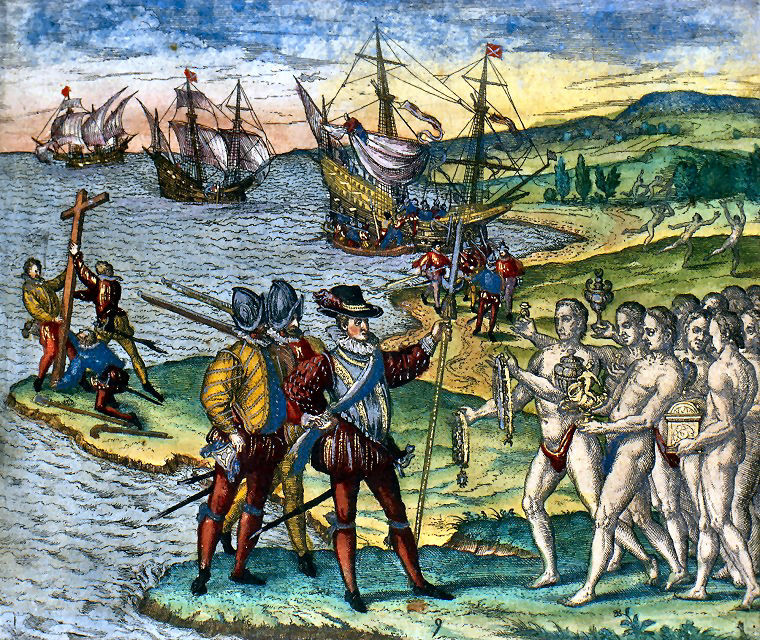
Christopher Columbus encountering Tainos. An engraving ca. 1594 by Theodor de Bry
Source
The 1492 discovery of America is extremely well documented, or at least much more so than any earlier ones, but the circumstances are exactly the same as those Scandinavian colonisations. We have Bartolomé de Las Casas to thank for his book, “A Brief Account of the Destruction of the Indies” which is an eye-witness and eye-watering account of the Spanish conquest and colonisation of the ‘East Indies’ or rather the Americas.
However, there is a huge problem with the reliability of this book as it has come down to us – and we apologise for this slight diversion. To begin with most academic authorities believe that Las Casas was prone to exagerration regarding his statistics. For another he was on a mission to prove a very difficult and delicate point to the new Spanish King, Filipe II, which modern academics regard as bias. To his credit, Las Casas was responsible for the the new Spanish colonial laws (the New Laws of 1542,) which abolished native slavery for the first time in European colonial history.
To complicate matters even further, his book was seized upon by the enemies of Spain and Catholicism to be used as future anti-papish propaganda. This occurred not only in England, but primarily in the Netherlands where his book was very loosely translated into other languages and illustrated in a sensational manner with graphic engravings. This was the birth of the ‘Legenda Negra’ or Black Legend of Spain which persists to this day having been augmented with similar propaganda from the period of the Franco regime.

Graphic illustration from the Dutch versions of “A Brief Account of the Destruction of the Indies.”
Guillermo Marín and "Gumr51 (uploader)", CC BY-SA 3.0
As if that wasn’t enough, the plot thickens even further. In the Spanish version of ‘A Brief Account’, which isn’t original as it in turn has been translated from Español Antiguo (Antique Spanish), Las Casas clearly, qualifies his references to ‘the Spaniards’ and ‘the Christians’ as those who claim to be or pretend to be Spaniards / Christians. None of these qualifications have been preserved in the translations – at least definitely not in the English version.
It’s no coincidence that the date of the original voyage of discovery - or at least the date that the crews boarded their ships and technically left the Spanish mainland – coincided with the deadline for all Jews to either convert or to leave Spain. Columbus’s voyage was largely financed by a wealthy Jew. There were rumours that King Ferdinand’s mother was Jewish. Converso Jews occupied a great many important and powerful positions in Spain, which is why Las Casas had to tread very very carefully.
However, that’s all another story. Anyway, bearing that in mind, we can now consider Bartolomé de Las Casa’s eye-witness account...
He talks of “an innumerable number of Islands, which we found so well peopled with Natives and Foreigners [?!*], that there is scarce any Region in the Universe fortified with so many Inhabitants.
[The modern Spanish is very different: “Hay otras muy grandes e infinitas islas alrededor, por todas las partes della, que todas estaban e las vimos las más pobladas e llenas de naturales gentes, indios dellas, que puede ser tierra poblada en el mundo.” There is no mention of Foreigners or universes.
“...And such a multitude of People inhabits these Countries, that it seems as if the Omnipotent God has Assembled and Convocated the major part of Mankind in this part of the World. Now this infinite multitude of Men are by the Creation of God innocently simple, altogether void of and averse to all manner of Craft, Subtlety and Malice, and most Obedient and Loyal Subjects to their Native Sovereigns; and behave themselves very patiently, submissively and quietly towards the Spaniards, to whom they are subservient and subject; so that finally they live without the least thirst after revenge, laying aside all litigiousness, Commotion and hatred.”
Columbus’ own account of his first encounter with the natives confirms the above and he marvels at their generosity and total ignorance of weaponry. He famously claimed that he could easily subdue them all with 50 men.
Because of his exaggerated report and promises, his second expedition consisted of seventeen ships and in excess of twelve hundred men (many of whom were conscripted convicts.) They went from island to island in the Caribbean, taking Indians as captives and searching for gold. However, before long, all they found were more and more empty and deserted villages.
Following the death of the Spanish Queen Isabel in 1504, things took a severe turn for the worse. Previously any abuse that occurred in the New World had been kept from the Queen, but with her out of the way it went into overdrive.
“It’s claimed that mass suicides began among the Arawaks of Haiti, by cassava poison. Infants were killed to save them from the Spaniards. In two years, through murder, mutilation, or suicide, half of the 250,000 Indians on Haiti were dead.” Source
“...of Three Millions of Persons, which lived in Hispaniola [Haiti] itself, there is at present but the inconsiderable remnant of scarce Three Hundred. Nay the Isle of Cuba, which extends as far, as Valledolid in Spain is distant from Rome, lies now uncultivated, like a Desert, and intomb'd in its own Ruins. You may also find the Isles of St. John, and Jamaica, both large and fruitful places, unpeopled and desolate.
“The Lucayan Islands on the North Side, adjacent to Hispaniola and Cuba,which are Sixty in number, or thereabout, together with with ...the Gigantic Isles, and others ...is now laid waste and uninhabited; and whereas, when the Spaniards first arriv'd here, about Five Hundred Thousand Men dwelt in it ...There are other Islands thirty in number, and upward bordering upon the Isle of St. John, totally unpeopled; all which are above Two Thousand miles in Length, and yet remain without Inhabitants, Native, or People. [Native or People? Are Natives not People?]
“As to the firm land [American Mainland], we are certainly satisfied, and assur'd, that the Spaniards by their barbarous and execrable actions have absolutely depopulated Ten Kingdoms, of greater extent than all Spain, together with the Kingdoms of Arragon and Portugal, that is to say, above One Thousand Miles, which now lye waste and desolate, and are absolutely ruined, when as formerly no other Country whatsoever was more populous. Nay we dare boldly affirm, that during the Forty Years space, wherein they exercised their sanguinary and detestable Tyranny in these Regions, above Twelve Millions (computing Men, Women, and Children) have undeservedly perished; nor do I conceive that I should deviate from the Truth by saying that above Fifty Millions in all paid their last Debt to Nature.” A Brief Account of the Destruction of the Indies.
In the 21st century we are very much used to the stock excuses for the genocide of the native american population – disease. However, Bartolomé de Las Casas does not present this as being a major factor. 50 million people is 4 million more than the current population of Spain, just to give it some perspective.
As explained previously these statistics may be exaggerated. Even If you halve them, just to be on the conservative side, it’s still an obscene number.
Of course, it has become ‘fashionable’ to claim that Caribbean Extinction is a myth, thanks to the ‘global Indigenous movement’ that began in the 60’s and 80’s and led to the revitalization of native pride and the right to either reconnect with one’s traditional past, or simply create one. However, this seems to conflict with the slavery claim.
Comparing this invasion / colonisation event with those mentioned previously, it’s obvious that the nature and character of the indigenous people of the Americas is practically an exact match to that of the Albans and the Finnar etc. What can’t be ascertained is how many of the American natives were actually Fae and how many were humans under their protection.
“I have been told by a friend in California, who is a student of psychical sciences, that there exist in certain parts of that state, notably in the Yosemite Valley, as the Red Men seem to have known, according to their traditions, invisible races exactly comparable to the ‘gentry’ of this Ben Bulbin country [County Sligo, Ireland] such as our seer-witness describes them and as other seers in Ireland have described them, and quite like the ‘people of peace’ as described by Kirk, the seventh son, in his ‘Secret Commonwealth’. These California races are said to exist now, as the Irish and Scotch invisible races are said to exist now, by seers who can behold them; and, like the latter races, are described as a distinct order of beings... If we follow the traditions of the Red Men, the Yosemite invisible tribes are probably but a few of many such tribes scattered throughout the North American continent.” ‘The Fairy-Faith in Celtic Countries’, by W. Y. Evans-Wentz, 1911.
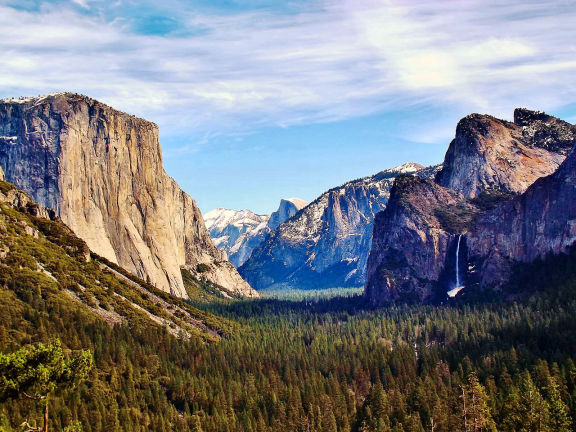
Yosemite Valley Source
In a post from 2018 in the original Stolenhistory.org forum, its founder, Korben Dallas, presented information and images concerning Native Americans with typical ‘caucasian’ features. In 2021 I have been unable to find the same images, but they are reproduced here from the archive of the post in stolenhistory.net
“Columbus set foot on Hispaniola in 1492. Cortez overthrew the entire Aztec Empire by 1521. Pizarro conquered Peru and defeated Incas by 1535. Yet the North American settlers barely made it to the Mississippi river by 1820. 300 year difference is bizarre. Did North American natives have better defensive equipment? Well, may be they did. May be they had an army to defend themselves. The one we will never be told about.” Source
Could an alternative explanation be that these ‘Caucasian’ looking people were not entirely human, but belonged to a divine, or semi-divine, Fae race similar to the Irish Tuatha de Danann and they simply and literally vanished in the face of the European invasion? This explanation doesn’t require “an army to defend themselves” with because there was no defence necessary and it also explains the rapidity with which the Incas and the Aztecs were ‘conquered’ compared to the settlement of North America.
Legends and indeed, even hard evidence, shows that there were giants and pygmies in America prior to the European colonisation. This is a sure sign that the Fae were present there at least in those forms, as evidenced by these links:
The Ancient Giants Who Ruled America
Ancient Pygmies in America
Giant Human Skeletons Found Buried in Mounds Across North America
Giants in West Virginia
The Ancient Race of Giants that Inhabited Mexico - Quinametzin
Ancient Giants Of America
Pigmy Tribes of the Ohio Valley
American Pygmies
It’s not hard to imagine how the Fae could easily vanish under such circumstances. What’s much more difficult to fathom is how flesh and blood human beings could do the same and yet the alternative is to believe that millions were horrifically butchered or sold into slavery. Personally, I find it just as hard to imagine how any human being could do that to another.
‘Physical Alchemy’ is a relatively fashionable term. It is both spiritual and physical transmutation and involves lots of meditation and payments to ‘gurus’ or our space brothers in order to perfect your ‘Light Body’. It’s very difficult to imagine how native people under the threat of mutilation, death and / or slavery could ever manage to achieve the required spiritual state that would allow them to transcend in a physically alchemical manner. This conundrum requires further thought...
When my brother and I were growing up, the Bermuda Triangle was big news. You will see from the image below that it’s in the exact area where Columbus landed in 1492. Nobody talks about the Bermuda Triangle these days. If you do an internet search you will notice that it has been reclassified as a ‘myth’. “Most reputable sources dismiss the idea that there is any mystery,” Wikipedia. “The Bermuda Triangle is a mythical section of the Atlantic Ocean roughly bounded by Miami, Bermuda and Puerto Rico,” History.com

The Bermuda Triangle
Public domain
“For hundreds of years, the Bermuda Triangle has been synonymous with mysterious disappearances. This infamous region in the western Atlantic Ocean, bordered by Miami, Bermuda, and Puerto Rico, has become a household term for a place where things simply…disappear. In the last century, 50 ships and 20 airplanes have either vanished, crashed, or sunk here. What makes this 1,294,994 sq km region apparently so dangerous?
“Author Vincent Gaddis coined the phrase “Bermuda Triangle” in the 1960s in an article he wrote for a famous pulp magazine called Argosy. It earned him a less-than-favorable reputation as someone who promoted “crackpot claims” and ignored normal explanations. Not long after, other writers began to weigh in, propelling the region into notoriety. It became a catch-all for the paranormal, from alien abductions to the lost city of Atlantis.
“Talk of the strange happenings in the Triangle dates back all the way to the Age of Discovery. Christopher Columbus was sailing through the triangle to Guanahani (now called San Salvador Island in the Bahamas) when he described seeing a light, shaped like a candle flame, vanish into the sea. At the same time, his compass went haywire.” Source
There will be more regarding this area later in the series...

Wikimedia Commons / Chensiyuan
By 600 C.E., the Maya had built thousands of cities around central America, but it began to decline in the 8th and 9th centuries. There’s no agreement as to why this happened. Source
(Some like to argue that the Mayan civilisation still survives, rather like some modern Italians who claim the same for The Roman Empire.)

Wikipedia / Henry Howe
In 1587, a group of 115 English settlers landed on Roanoke Island, off the coast of modern day North Carolina. After a few months their governor, John White, sailed back to England for supplies. Due to unforseen circumstances, he didn’t get back until three years later, in 1590, when he found the colony completely abandoned. There was no sign of the settlers other than a tree with the name "Croatoan" carved into it. There is still no explanation. (ibid.)

Wikimedia Commons / Usman
Ruins of a highly advanced and prosperous society, known as the Indus Valley Civilization, can be found in and around the floodplains of the Indus River, in what is currently Pakistan and northwest India. Archaeological evidence suggests it was at its peak around 2500 B.C.E when they had a written language, sewage systems, and agriculture. By 1800 B.C.E it was abandoned and no one knows exactly why. (ibid)

Flickr / Zwegers
Easter Island is famous for it's massive head statues, called Moai. They were made by the Rapa Nui people, who’s population was around 12,000 at its peak. European explorers arrived on Easter Sunday in 1722, when the Dutch crew estimated that there were 2,000 to 3,000 inhabitants on the island. Subsequent visits reported fewer and fewer inhabitants each time until eventually, the population dwindled to less than 100. (ibid)
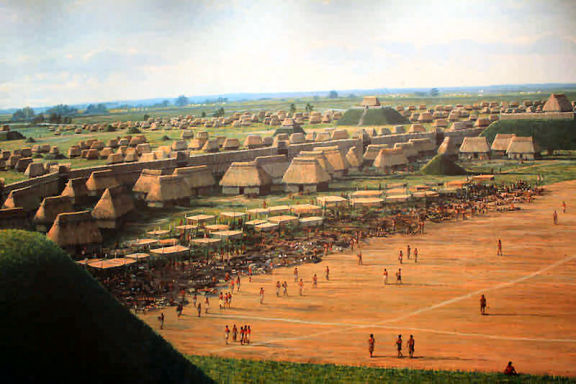
GoodFreePhotos.com
“Cahokia was a Native American civilization in modern day Illinois. It is estimated to have supported a population of 10,000-20,000 and have spanned over six square miles at it's peak during 1050-1200 C.E. The city inhabitants lived in mounds that were all abandoned by 1400, before Columbus or any European explorers had come to the new world. No one knows for sure why the city was abandoned, but overhunting, deforestation, disease and flooding are all suspected.” (ibid)

Wikimedia Commons
The Khmer Empire was at its height around the 12th century, when it controlled much of modern South East Asia. In fact, it's the largest preindustrial society known to date. By 1500, the entire city had been abandoned and began being taken over by the jungle.” (ibid.)

Flickr / Voron
The metropolis of Petra was the center of the Nabatean Kingdom which was four times the size of modern Jordan and had a sophisticated water management system. By the 8th century it was abandoned. It was relatively untouched for centuries until western explorers discovered it in the 1800s.” (ibid.)

Wikimedia Commons / Hajor
The Olmecs established themselves along the Gulf of Mexico around 1100 B.C.E. Although most evidence of their structures has disappeared, many enormous carved heads remain to commemorate their existence. “All archaeological evidence of the society disappeared after 300 B.C.E. Their graves have since disappeared, so it's impossible to determine why or if they were killed by disease or force.” (ibid.) No graves eh? Hmmm...
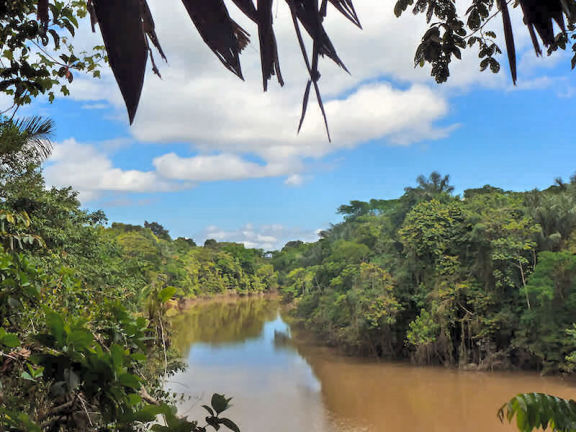
Flickr / Global Water Forum
On the basis of reports written by Spanish conquistadors regarding cities made from gold and vast civilizations in the Amazon, many treasure hunters went in search of them throughout the ensuing years. However, they found no sign of human life in the thick jungle. So-called ‘satellite imagery’ has shown there might be some truth to the original reports. The photos reveal evidence of large structures and even agricultural systems in the jungle. “These people were one with the river, and their villages were often called ‘garden cities.’ [Presumably in the original reports of the conquistadores] However, there was no obvious evidence of them centuries ago, and it is assumed that they were wiped out by disease brought over by explorers looking for El Dorado. [Even though they never came in contact with them]” (ibid.)
“History holds many oddities that we may never fully understand, either through incomplete documentation, disinterest at the time, or simply a big question mark that hangs over all. Among these are mysterious tribes of people that have been encountered and confronted in all corners of the globe, often vanishing before we really understand them and leaving us perplexed at just who they were or where their origins lie.” Source
In the early 1700’s, French explorers encountered the Mandan tribe in the region of the Missouri River (present-day North and South Dakota.) They possessed rather fair skin, red or blonde hair and blue or grey eyes. The women in particular [were] reportedly to be indistinguishable from white people.
In 1804 Lewis and Clark described them as “half-white,” as well as peaceful, civilized, courteous, and polite. They also reported how frequent small pox epidemics and attacks by neighboring tribes had depleted their numbers. “In 1838 the tribe was hit by a devastating smallpox epidemic, and although this was a specter they had been haunted by for centuries, this time it was absolutely catastrophic, wiping them out at such a rate that after only a few months there were only an estimated 30 to 140 of them left. With the Mandan teetering on the edge of extinction, enemy tribes swept in and took them as slaves, after which they were assimilated and absorbed.” (ibid.) By the Borg perhaps?
Here we have the usual smallpox excuse once again, except this time even though it was something “they had been haunted by for centuries, it was absolutely catastrophic, wiping them out.” So, they hadn’t developed a natural immunity to the disease over the previous centuries then? The handful who managed to survive were quickly snaffled up as slaves. ‘Play it again, Sam.’
In the article entitled “The Spanish Flu Pandemic of 1918,” Felix ended with a description of the 1862 Smallpox Epidemic in Victoria, British Columbia. In it he demonstrated how the disease was used to remove native populations from areas being settled by white people. This was achieved through the distribution of infected blankets and primitive vaccination. In other words, without the deliberate introduction of the disease, the native population would probably not have been affected.
As Korben Dallas said:
“Additionally we have those perfectly healthy vikings headed by the incredible Leif Eriksson, who failed to bring a single "killer disease" to the North America.
“I think you see where I'm going with this. All these so called "killer diseases" were present in the Americas ever since the time of the Global Empire [pre-Columbus.] Especially when the Bering Strait is only 51 miles wide. Whatever killed 90% of the Native American population, probably, did not get as much help from diseases as we were led to believe.” Source
Judging by the figures we have presented for the number of people who have disappeared in the face of colonisation, there are many of ‘us’ already living lives that are just beyond the reach of our vision. We tried to get reliable figures for the number of people who go missing in the modern world, but it’s a thankless task. It’s impossible to know if they are reliable or massaged for the ‘fear effect’. The closest we could get was 4,432,880 Missing Persons who have vanished in the past 20 years. Source
So it seems that, even today, some of us are still escaping.
The rational explanations for all of these disappearances are, of course, plausible. Such a premise as people simply vanishing could never really hope to be supported by definitive evidence, because by its very definition, it leaves no evidence.
For this reason I would now like to pursue the quest from the opposite end by attempting to examine a matter about which Tolkien declared, “I will not attempt to define that, nor to describe it directly. It cannot be done. Faërie cannot be caught in a net of words; for it is one of its qualities to be indescribable, though not imperceptible. It has many ingredients, but analysis will not necessarily discover the secret of the whole.”
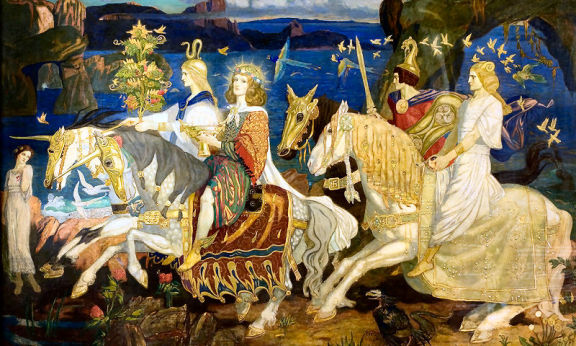
The Riders of the Sidhe, Tempera on canvas, John Duncan, 1911
Source
“At one time it was a dominant view that all such matter was derived from ‘nature-myths.’ The Olympians were personifications of the sun, of dawn, of night, and so on, and all the stories told about them were originally myths (allegories would have been a better word) of the greater elemental changes and processes of nature. Epic, heroic legend, saga, then localized these stories in real places and humanized them by attributing them to ancestral heroes, mightier than men and yet already men. And finally these legends, dwindling down, became folk-tales, Märchen, fairy-stories—nursery-tales.
“That would seem to be the truth almost upside down. The nearer the so-called ‘nature myth,’ or allegory, of the large processes of nature is to its supposed archetype, the less interesting it is, and indeed the less is it of a myth capable of throwing any illumination whatever on the world. Let us assume for the moment, as this theory assumes, that nothing actually exists corresponding to the “gods” of mythology: no personalities, only astronomical or meteorological objects. Then these natural objects can only be arrayed with a personal significance and glory by a gift, the gift of a person, of a man. Personality can only be derived from a person. The gods may derive their colour and beauty from the high splendours of nature, but it was Man who obtained these for them, abstracted them from sun and moon and cloud; their personality they get direct from him; the shadow or flicker of divinity that is upon them they receive through him from the invisible world, the Supernatural. There is no fundamental distinction between the higher and lower mythologies. Their peoples live, if they live at all, by the same life, just as in the mortal world do kings and peasants.” ‘On Fairy Stories’ by J. R. R. Tolkien, 1939.
Superstition is now mostly all that remains of the folklore that once constituted daily life. Folklore is nothing more than the habits that folk lived by in times past. These habits were defined by their environment, their experiences, their relationships and their beliefs. The habits of modern life will be the folklore of the future and God help anyone trying to understand it.
It’s in the area of belief that the greatest influence upon people’s habits occurred some 2,000 years ago. Later the industrial revolution had the most profound effect upon the environment. Later still the two World Wars brought traumatic experiences. Each of these landmarks affected people’s habits and the folklore changed as relationships with the natural world were broken and lost.
Now science and technology burn so brightly that it blinds belief, destroys the environment, dulls experience and makes relationships redundant, for we are all nothing but the result of a freak accident and a constant fight against nature and each other, for survival. There is no magic in the world, it’s just misunderstood technology - smoke and mirrors and quantum string. The only habits people have left now are all bad ones.
“There be few among us who have not felt evanescent regrets for the displacement by the foi scientifique of the old faith in fairies. There was something so peculiarly fascinating in that old belief, that ‘once upon a time ' the world was less practical in its facts than now, less commonplace and humdrum, less subject to the inexorable laws of gravitation, optics, and the like. What dramas it has yielded! What poems, what dreams, what delights!
“One can no longer rest in peace with one's ignorance.” British Goblins - Welsh Folklore, Fairy Mythology, Legends And Traditions, by Wirt Sikes, 1880.
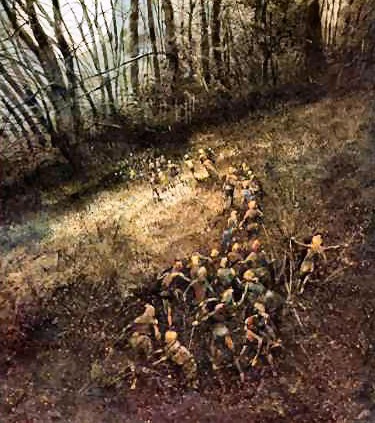
Artist unknown, ‘A Fairy Departure’
Source
Having studied many books on folklore, which between them span a large period of our past, it is a curious fact that during every period belief in the Fae and in Faërie is always consigned to the past or to other areas.
Seven hundred years ago Chaucer wrote:
“In olde dayes of the Kyng Arthour, (In the old days of King Arthur)
Al was this lond fidfilled of fayrie, (This land was full of fayrie)
I speke of many hundrid yer ago, (I speak of many hundred years ago)
But now can no man see non elves mo. (But now no man can see elves anymore.)"
Wyf of Bathes Tale, (The Wife of Bath’s Tale) Canterbury Tales.
John Dryden was saying the same thing two hundred years later:
“I speak of ancient times, for now the swain (country person)
Returning late may pass the woods in vain,
And never hope to see the nightly train.”
‘Fables Ancient and Modern’, John Dryden, 1700
In other accounts the fairies are perennially said to be dwindling and on the verge of leaving, usually because they find it impossible to exist in this world with all of its hatred and avarice.
More recently the loss of connection with the Realm of Faërie is fixed to the year of 1850 and blamed upon the Industrial Revolution. The sudden increase in materialism and the plunge into a consumer society are the obvious factors. The expansion of the railway, with its initial use of iron for tracks as well as locomotives, was seen as an additional reason. We have an article on the site entitled Iron, the Great Protector – Its Removal from Society which illustrates its traditional use as protection against evil spirits. Exactly what effect it has on the Fae is debatable, but it seems that for some it’s the actual working or blacksmithing of Iron that is the issue.
The connection that humans make between their own social and moral decline and the disappearance of the Fae is extremely interesting. Clearly the Fae haven’t disappeared as often as has been claimed, but we seem to expect the absence of the Fae as some kind of justly deserved ‘divine retribution’. We blame ourselves for their supposed absence or rather we recognise that the degeneration of society is the cause and their absence is the effect. Therefore this degeneration, by our own estimation, has been going on for at least the last 700 years.
Different theories regarding the origin of the Fae have been fashionable at different times. The onslaught of Christianity has labelled everything Fae as demonic from the very earliest times. In the 16th century Paracelsus claimed that they were all simply nature spirits. I think Tolkien has already dealt with that theory most efficiently. During the 19th century it was proposed that the “first fairies” were mortal and later superstitions were simply echos and embelishments of stories that were told about these original people. One writer suggested that they were the Druids who were forced into hiding due to persecution by Christians and Romans. Another claimed they were “some conquered aborigines” who were also pygmies. More recently there are no theories as it’s all considered pure fantasy made up of anthropomorphism and personification.
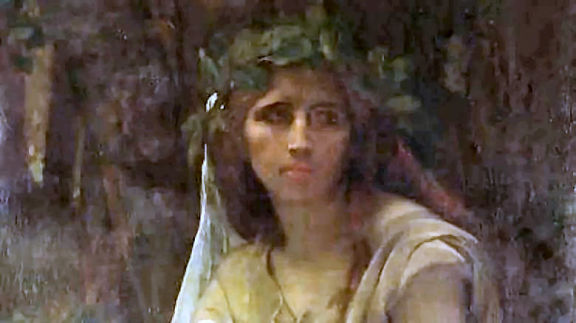
Druidess
Source
Apart from the latter theory, I believe the other two could both be relevant. Fortunately, there has always been a strong enough body of belief in the existence of The Realm of Faërie and it isn’t just comprised of small children.
Continued in Chapter Two...
Will Scarlet & Felix Noille
.
IF YOU ARE SEEING A LINK TO MOBIRISE, OR SOME NONSENSE ABOUT A FREE AI WEBSITE BUILDER, THEN IT IS A FRAUDULENT INSERTION BY THE PROVIDERS OF THE SUPPOSEDLY 'FREE' WEBSITE SOFTWARE USED TO CREATE THIS SITE. THEY ARE USING MY WEBHOSTING PLATFORM FOR THEIR OWN ADVERTISING PURPOSES WITHOUT MY CONSENT. TO REMOVE THESE LINKS I WOULD HAVE TO PAY A YEARLY FEE TO MOBIRISE ON TOP OF MY NORMAL WEBHOSTING EXPENSES - WHICH IS TANTAMOUNT TO BLACKMAIL. I CALCULATE THAT THEY CURRENTLY OWE ME THREE MILLION DOLLARS IN ADVERTISING REVENUE AND WEBSITE RENTAL.